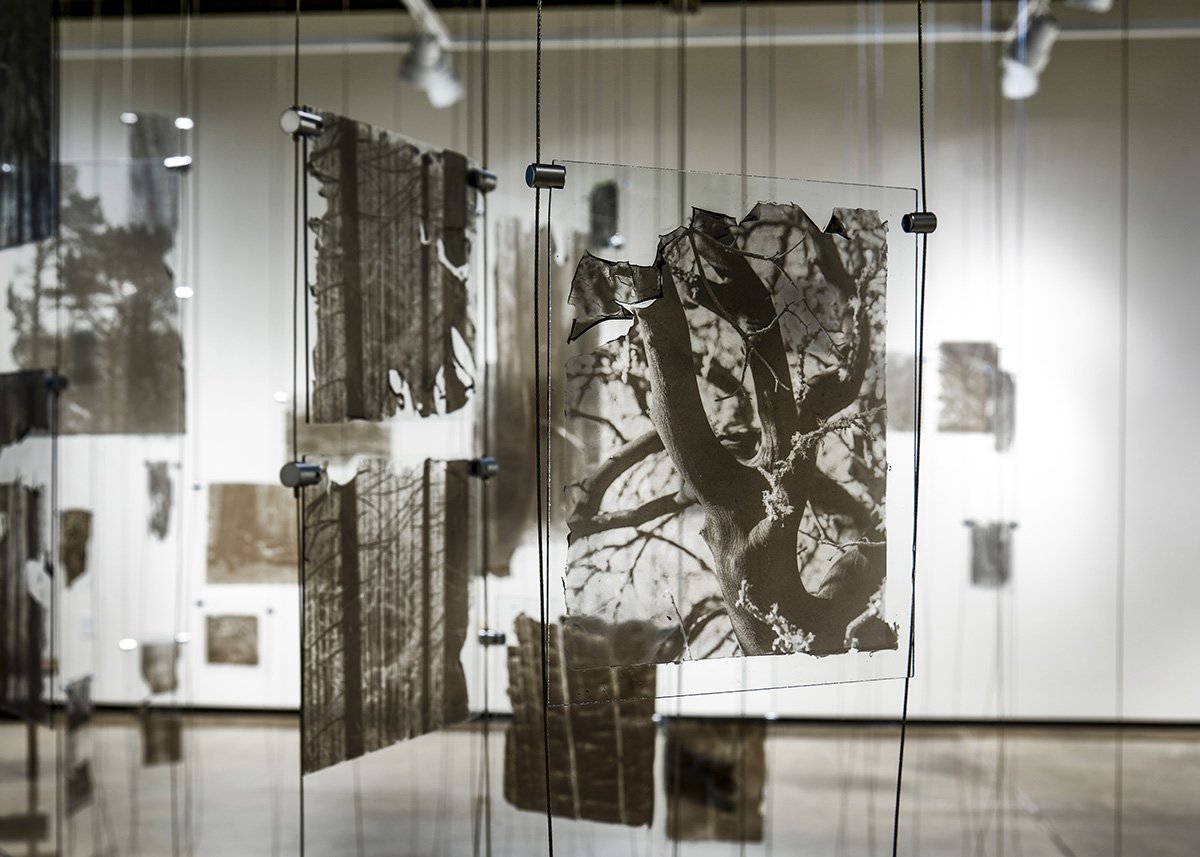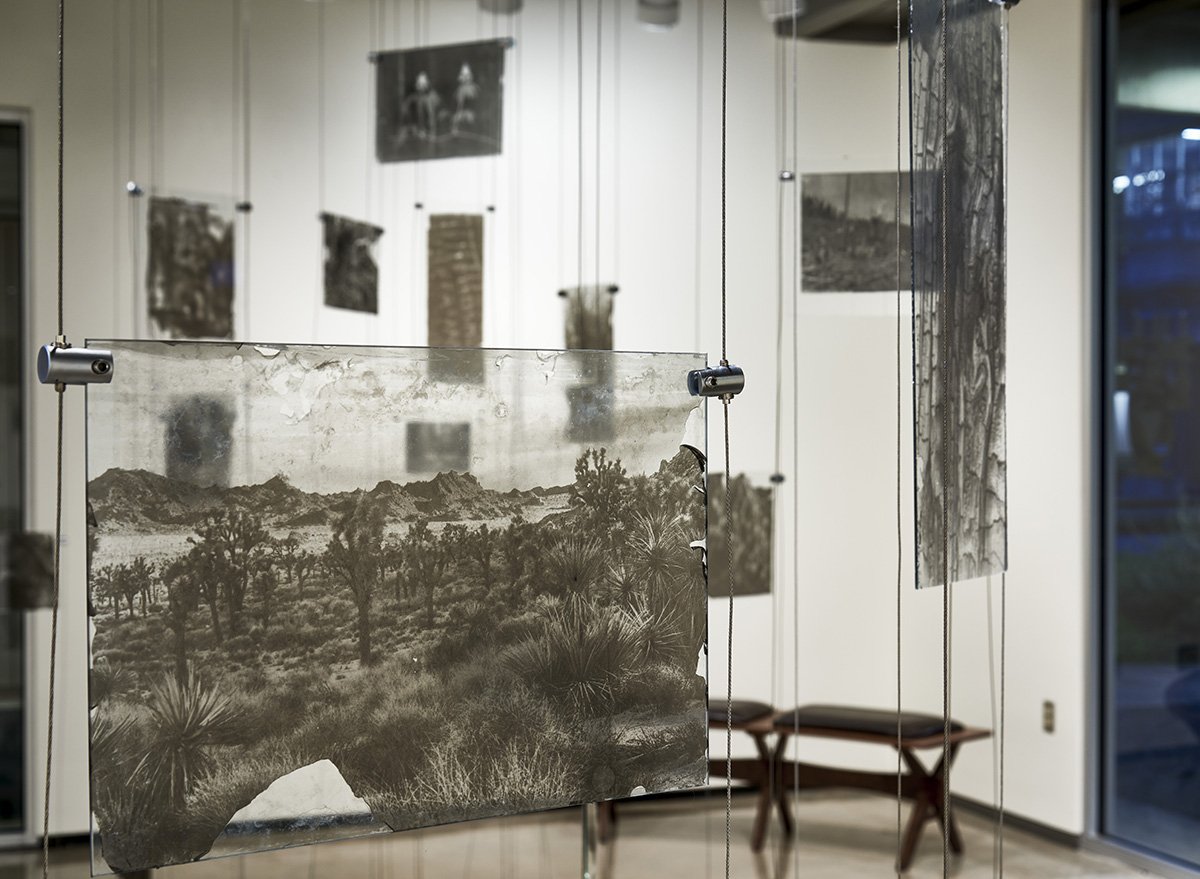Poignant Portfolio no. 43: Sarah Grew
From the Editor
Once again I have the opportunity to highlight some photographic work that addresses climate change, particularly the devastating fires seen in Oregon in 2020. This is undoubtedly not an issue relegated to that particular state because, as a Californian myself, I can tell you that there have also been some depressingly intense blazes that have occurred here in recent years. It’s an ongoing problem and one that the artist community frequently addresses quite succinctly.
Remember that famous quote from Ansel Adams? – “The negative is the score, and the print the performance.” Well, Sarah Grew takes this idea a major step forward with her latest project, Ghost Forest.
As an artist, Grew explores her intentions through a variety of media, including photography, painting, printmaking, installation, and collage. For this latest series, she combines alternative photographic processes with installation to create something that piques the imagination with a visual tapestry worth experiencing. Photographic representations of living forest scenes are made as lantern slides using the carbon printing method on glass, with the carbon harvested from the actual coals left behind from the fires. The glass plate images are then hung towards the center of a room to represent the Ghost Forest. As a result, the experience is hypnotic and interactive. Grew also does an incredible job of rigging the individual plates adeptly throughout the installation through a combination of cables and glass mounts.
Having had the experience of visually inspecting some of these plates myself, this was interesting to encounter the frayed and torn edges, not to mention the artifacts from the process itself, reminiscent of burn marks, on each piece. This, coupled with the fact that viewing the plates from one side or the other, creates a visual shift when peering through the translucent emulsion, creating a constantly changing experience when viewed as a complete installation.
Building an installation exhibition of this magnitude takes time, serious thought, rigorous experimentation and engineering, and intention to present an event this immersive. Grew’s mastery of the carbon printing method is evident throughout the project, and with it comes the educational aspects found in the creative vision of an artist who wishes to inform as well as astound. A series such as this is what gets people talking, expanding upon the discussion of climate change, conservation, and biodiversity.
Those in the Greater Portland area have the opportunity to see this installation for themselves at the LaVerne Krause Gallery on the campus of the University of Oregon, opening April 24, from 9 am - 6 pm. Click here for additional information.
Ghost Forest
Ghost Forest grew out of my need to speak about one of the burning issues affecting our planet: the climate crisis. Every summer huge wildfires rage across the west coast of the U.S. burning an average of 7 million acres a year. The fires are so big they create their own weather patterns, it rains ash across the country and the sun is blotted out of the sky. My desire to create something out of the ruins led me to visit fire sites and collect black carbon soot. Carbon, the fundamental building block of life and the remains of a fire. I soon realized I could create carbon prints, transforming the charred wood into recorded images of the forests themselves. After extensive experimentation, I am now making prints from the ash of many wildfires. Invented in 1855, the carbon print is considered one of the most archival of all photographic printing processes with an estimated life of 10,000 years. Carbon does not fade. Instead, in my hands, the burned remains of the trees become photographs. My process and its resulting prints, with their frilled edges and torn emulsion echo the way natural fire cycles can surmount devastation to provide nutrients to the soil, force a pinecone to disperse its seeds, or shape the landscape, in stark contrast to the extreme intensity and size of the fires that are now common. The photographs show us the beauty being lost to human negligence and the climate crisis.
Printed as lantern slides, the forest memory is held captive on sheets of glass accentuating both the fragility of life and our precarious position. When installed, the Ghost Forest moves photography off the wall and into the middle of the room. The photographs on glass hang from the ceiling on pairs of cables that suggest the outline of trees. Hung at various heights the viewer is invited to move through my forest, witnessing a range of natural elements; small understory flowers, waterfalls, dappled light in the trees, a burned branch that has travelled down river to the ocean, as well as the aftereffects of fire.
My intention is to transform the devastation from the sick panic of needing to evacuate to one of beauty with awareness. In the U.S., there have been an average of 70,000 wildfires each year for the last 10 years, 90% of them caused by humans. The Ghost Forest has 70 trees, a picture is worth a thousand fires.
–Sarah Grew
[clicking on a thumbnail will bring up a lightbox]
INSTALLATION VIEWS
About the Artist
Sarah Grew creates art based in painting and photography, that expands into installation and environmental art and contracts into collage and printmaking. Her work includes a range from public art projects to wall based pieces belonging in private collections nationally and internationally. In researching the concepts that enrich her work she has become a beekeeper, studied native plant habitats, and worked as an Artist-in-Residence for a recycling facility in California. Recently, she was an artist in residence on a science research boat studying the effects of climate change on the plankton food web. Previously, Grew was awarded residencies at Sitka Center for Art and Ecology, Playa Artist Residency, the Djerassi Resident Artist Program, Joshua Tree National Park, the Collegeum Phaenomonologicum in Italy, Brush Creek and the Ucross Foundation. She has also received several support fellowships from The Ford Family Foundation. Currently, Grew is working on a several of time-bending projects; paintings that examine modes of expressing time through layering visual art technologies from different periods and concurrently, a photography project using early printing methods to speak to climate change and the fragility of our planet.
sarahgrew.com
@sarah.grew
About the author
Michael Kirchoff works in the worlds of both commercial and fine art photography. A commercial shooter for over thirty years, it is his fine art work that has set him apart from others, with instant film and toy camera images fueling several bodies of work. His consulting, training, and overall support of his fellow photographic artist continues with assistance in constructing one’s vision, reviewing portfolios, and finding exhibition opportunities, which fill the gaps in time away from active shooting.
Michael is also an independent curator and juror, and advocate for the photographic arts. Currently, he is also Editor-in-Chief at Analog Forever Magazine, and is the Founding Editor for the online photographer interview website, Catalyst: Interviews. Previously, Michael spent over four years as Editor at BLUR magazine.
Most recently Michael joined the Diffusion Tapes podcast as co-host.




















